Chapter 7
Japan
In the eighth century, when Buddhism was adopted in Japan as a state religion endowed with economic, political, and even magical curative powers, every temple had need of a complete set of the sacred texts. It is estimated that in the middle decades of the century, in the dozens of scriptoria that flourished in the capital at Nara, more than 120 thousand scrolls of Buddhist text were copied out by professional scribes as well as by monks and laymen. Organized for maximum efficiency, like a modern production line, the calligraphers transcribed the Chinese scriptures in a severe, disciplined style. Their goal was simply to set down the words of the Buddha with maximum clarity and legibility so that the message of universal salvation could be spread throughout the nation. Self-expression was rigorously suppressed, and in both form and content Chinese models were faithfully reproduced.
The illustrated Sutra of Cause and Effect, Past and Present (Pl. 79] is the oldest Japanese narrative scroll painting as well as Japan’s oldest illuminated sutra. The original Sanskrit text no longer survives, but it was translated into Chinese by an Indian monk in the fifth century and illustrated Chinese versions were soon produced with narrative scenes in the upper register and text in the lower, in a manner favored in Tang books (figs. 87-88) and scrolls. Although painted Chinese versions have not survived, it must have been a Chinese import of the middle or late seventh century that inspired the popularity of this sutra in eighth-century Japan, where many sets ol eight or ten scrolls each were copied out, probably in the imperial atelier in Nara. (The sutra fell into disuse after the ninth century, when esoteric sects and worship of Amitabha, the savior of the Western Paradise, came to dominate Japanese Buddhism.)1 No complete set of the illustrated version has been preserved, and the fragment shown here is the only segment of four remaining scrolls that is known to have left Japan. All are transcribed in a regular, formal Tang style; costumes, hairstyles, and modes of composition are equally faithful to Chinese orginals.
The Sutra of Cause and Effect, Past and Present describes the life of the founder of the religion in easily comprehensible form; the Buddha answers questions about his former incarnations, his life as a young prince, and his final enlightenment achieved after performing countless good deeds in his previous lives. The scene illustrated depicts Sakyamuni as a monk demonstrating to three brahmin recluses, the Kasyapa brothers, the superiority of the Buddhist faith over the Hindu religion. The landscape elements are no more than ideographs providing a rudimentary setting for each episode, but “the figures are set onto the ground plane in such a way that they establish a clear position in depth and relate to one another in a psychologically meaningful manner.”2 Simple yet subtle, the painting has a naive, ingenuous beauty that compels our admiration. One character of the text, meaning ear, was cut out of the sixth line of this section, presumably to make an amulet for someone with a hearing problem.
Learned Japanese clerics, the elite of the Buddhist faith, traveled to the holy centers in China to study and returned with gifts of paintings, prints, and sculptures to be used in propagating the law. Saicho {766 or 767-822) and Kukai (733 or 734-835) were renowned pilgrims of the early ninth century. Chonen (d. 1016) stayed at the Northern Song capital in Henan in the tenth century, returning with a copy of the first printed Chinese Tripitaka, among other things. Even during the eleventh and twelfth centuries, when Japan was relatively isolated from the mainland, wealthy private entrepreneurs encouraged trade missions that guaranteed the continued importation of luxury goods from the mainland. The clearest evidence of this sort of cross-cultural interaction are Japanese wood statues whose hollow interiors were carefully filled with sacred objects, including Chinese printed manuscripts. One such example is the statue of Prince Shotoku (the revered sixth-century Japanese statesman) as a two-year-old boy, now in the Sedgwick collection on loan to the Harvard University Art Museums (fig. 107). Legend has it that when the two-year-old prince placed his hands in prayer and uttered his first words of homage to the Buddha, a relic of the Buddha Sakyamuni appeared miraculously in his hands. The child-god enjoyed a vogue during the thirteenth and fourteenth centuries, when the cult of the deified Shotoku was at its peak. Among the votive items found in a linen bag that had been sealed inside the statue were Japanese manuscripts bearing dates of 1282 and 1292, the latter being the likely date of the dedication. The most significant of the donations was a Lotus Sutra of the accordion-folded book type printed in either Hangzhou, the capital of Southern Song China, or in the nearby coastal city of Ningbo, in the midtwelfth century. The manuscript was found in a twelfth century Japanese wrapper described by John Rosenfield as “quite soiled and worn, giving evidence of the book having been in long use before it was placed inside the Shotoku statue.”3 A very long frontispiece [fig. 108] illustrates the contents of the entire sutra, spread out in front of the Buddha who preaches his sermon on Vulture Peak at the upper-right corner. The central placement of the stupa (a multistoried pagoda] of the Buddha Prabhutaratna from Chapter 11 gives the composition a measure of stability.

A second printed Chinese Lotus Sutra of about the same date was discovered in 1983 among the dedicatory objects packed inside a wood statue of Bodhisattva Kshitigarbha in the Museum fiir Ostasiatische Kunst, Cologne (figs. 109-110). The dedicatory scroll was written by a priest of the Jizo-in (a chapel for the worship of Jizo, i.e., Kshitigarbha) just south of Kyoto. The dedication is dated 1249 and credits the sculpture to master carver Koen (born 1207). Two small gilt-bronze Buddhas found inside the head were smeared with human blood, a rather surprising and unique occurrence. According to Roger Goepper, “it seems that the priest consecrating the figure ... and perhaps other persons partaking in the ceremony had sacrificed drops of their blood to establish a close and magical relation (kechien) with the holy essence personified in the figures.”4 The individuals who financed this donation were apparently of the upper levels of society, with at least six members of the highest noble family, the Fujiwara, and one former prime minister. This Lotus Sutra was printed in Hangzhou in the twelfth century and features a hieratic composition centered around a larger image of the preaching Buddha.5
Equally intriguing is a set of the Lotus Sutra in handscroll format in the Sorimachi collection transcribed in 1163 in gold and silver on indigo paper with what appear to be Chinese frontispieces joined to scrolls of text transcribed in Japan (fig. 111). Each character of the text is enshrined inside a miniature silver stupa, a vivid realization of the Buddha’s admonition to respect the Lotus Sutra as an embodiment of the Buddha himself. The frontispieces are identical in composition and style to the twelfth-century Chinese printed set in the National Palace Museum, Taipei, discussed earlier (fig. 94), except thai the originally oblong Chinese image with Sakyamuni on a platform at the far right has been cut in half, apparently to suit the square format and smaller scale favored in Japan. The Chinese frontispiece of fig. Ill would originally have accompanied Volume 4 of a seven volume set. In Japan, where the Lotus Sutra is transcribed in eight volumes and the fifth volume begins with Chapter 12, including the episode of Manjusri arising from the sea, the illustrations had to be readjusted accordingly.6
From the ninth century, when Japan severed official ties with China, religion became increasingly personalized and state temples such as the awesome Todaiji gave way to private chapels. During the Heian period, which encompasses the early ninth through the late twelfth centuries, power, prestige, wealth, and culture were concentrated in the hands of an elite group of courtiers in the new capital at Kyoto. These men and women were dedicated to the cultivation of good taste and a refined, elegant life-style. Poetry, literature, and the arts flourished under their patronage.
In the literature of the period, one can detect a certain melancholy world-weariness. It became quite fashionable to yearn for retirement in a mountain retreat in order to pursue matters of personal salvation. This pessimism was related directly to the prevalent belief in the imminent advent of Japan’s dark age, the Mappo (literally, the end of the Buddhist law), a prediction received with ominous foreboding. According to one method of accounting, Mappo was scheduled to begin in 1050, and in a small, closed society governed by religion and superstition such matters were taken very seriously indeed. Mappo was to be a period of one thousand years during which the Buddha’s teaching would remain, but men would no longer understand it nor attain enlightenment on earth. To preserve the Buddhist faith during this time of trial until the coming of the Buddhist messiah Maitreya, texts and ritual implements were buried in carefully prepared bronze and ceramic capsules (figs. 112-14).7 The burial of these time capsales in sutra mounds became a nationwide phenomenon in the eleventh and twelfth centuries. Most cases are cylindrical, gilt-bronze vessels surmounted by a lid with small rings and knobs resembling the spire of a Buddhist pagoda.
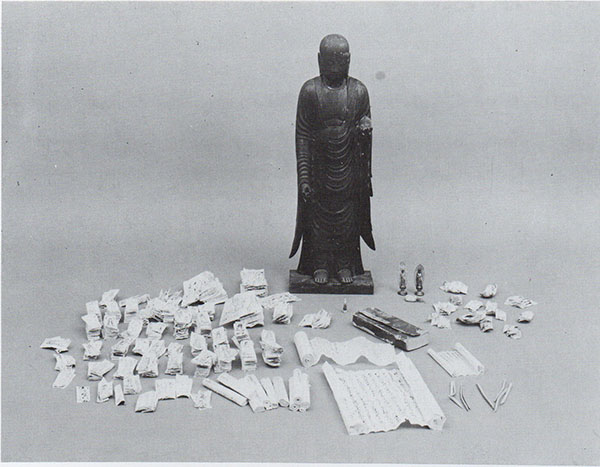
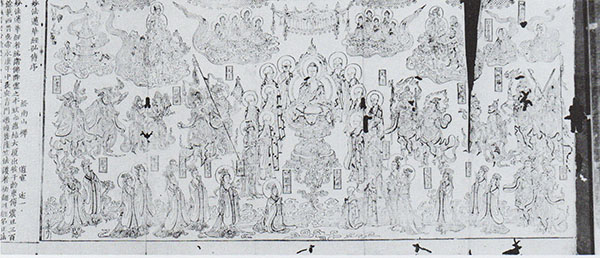
The earliest known burial of this sort occurred in 1007 when Fujiwara Michinaga (966-1027), then the most powerful political figure in the country (and known to us as the patron of Lady Murasaki), chose Mount Kimbu, a sacred place south of Nara, as the site for his own sutra deposit. Popular belief held that Maitreya would appear near the summit of the mountain, and an elaborate sanctuary grew up around the shrine of Zao, the local Shinto mountain deity who became a protector of the site. From Michinaga’s diary we know that he spent months preparing for this pilgrimage, reading and writing sutras, abstaining from meat and wine, and cleansing himself in baths of hot salt water. He finally left the capital in early September with a party of seventy-five persons, reaching the summit of the mountain one week later. After offering prayers and making the rounds of the lesser shrines, they gathered in front of the Hall of Zao and buried the sutra texts. Michinaga’s scrolls remained undisturbed until 1671, when the hall was refurbished and the sutra cases uncovered; the texts were found to be partially destroyed by moisture and corrosion.8
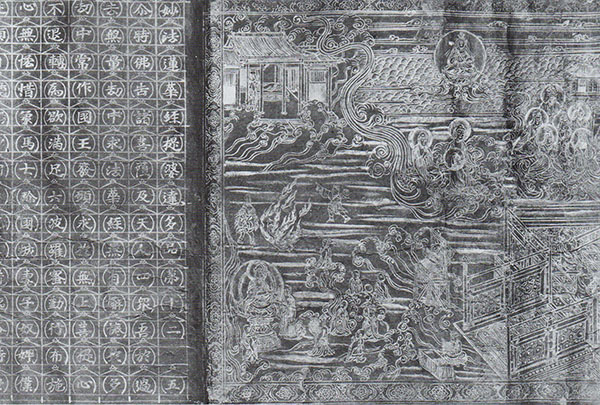
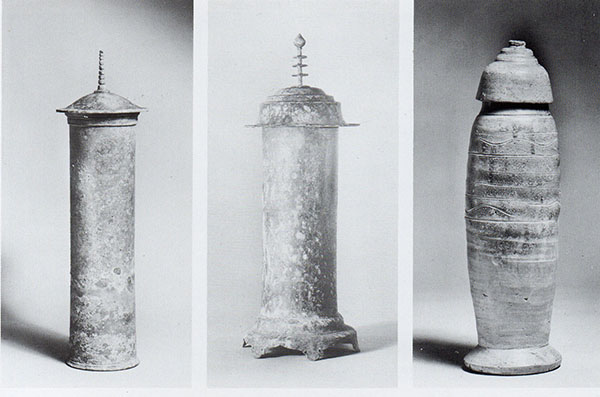
[center]Fig. 113. Sutra case. Japan; Heian period, 1100-1150. Patinated bronze. H. 44.5 cm. The Mary and Jackson Burke Collection, New York.
[right]Fig. 114. Sutra case. Japan; Heian period, 1100 - 1150.Baked clay with thin, olivebrown glaze. H. 38.5 cm. Kimiko and John Powers Collection.
A higher class of sutra, written in gold and silver inks on colored paper, has continued to find favor with wealthy lay donors even until the present day. Dedications in late Heian times were not associated with prayers for rainfall or the safety of the nation, as they might have been in the eighth century, but rather with penitential rites on behalf of deceased ancestors. Many sponsors frankly valued these religious events as an insurance of their own salvation: living in the shadow of Mappo, donors were increasingly motivated by the apprehension that surviving relatives might not be able to afford proper memorial services on their behalf. Such private donations at times assumed monumental proportions. A set of five thousand scrolls, the entire Buddhist canon, was presented in 1126 by a prosperous branch of the Fujiwara family to Chusonji, a remote northern monastic complex near Sendai (pis. 80-81). (Most of the scrolls were transferred to the Kongobuji on Mt. Koya in the sixteenth century.) This project required ten years to complete and necessitated the importing of professional scribes and artists from Kyoto. The set was dedicated the year the donor, Fujiwara Kiyohira, died. It would seem that as he approached the end of his life he decided to apply for spiritual merit, making a kind of downpayment toward a felicitous rebirth in the next life.
Despite the staggering volume of production, the quality of many of these scrolls is absolutely superb. The text is written in alternate lines of gold and silver ink, and the illuminations are evocative, almost ethereal, the deities engulfed in diaphanous silver clouds A Japanese style in sutra painting had already emerged by the eleventh century with works such as an eight-volume silver-character Lotus Sutra dedicated at Enryakuji, the great Tendai monastery on Mount Hiei (fig. 115). The major deities are large and generous in scale but flattened by a dense, allover patterning of richly detailed costume, halo, and pedestal so that the picture surface seems to overflow with a lavish stippled effect. The Kiyohira Tripitaka of 1126 is even more abstract. The conventional grove of trees behind the Buddha and bodhisattvas, for example, has been reduced to balloonlike clumps of golden foliage, with no visible source of support, adorned with decorative jeweled nets. Broad, undulating bands of mist unify and flatten the surface, eliminating any sense of depth.
The gold and indigo sutra style reached its peak in the midtwelfth century and is exemplified most clearly by another major transcription project known as the Jingoji Tripitaka (Pl. 82 and fig. 117). This set was initiated by the Retired Emperor Toba (r. 1107-23) around 1149 (the date inscribed on several of the wood sutra axles) and may have been intended for dedication during his pilgrimage to Kumano Shrine in 1153. The set was presumably transferred to the Jingoji, a mountain monastery outside Kyoto, by his son, Goshirakawa (r. 1155-58) who lived at this temple after he abdicated the throne.9 The rectangular seal of Jingoji was stamped in dark red ink between the frontispiece and the first line of the text. There were some five thousand scrolls (4,722 scrolls were still in situ in the eighteenth century), and it is only natural that they became repetitive, especially if the artists, assembled in specialized sutra workshops, were working under the pressure of a deadline.Artists apparently lacked the leisure to be inventive, and images were reduced to stereotypes. The shortcuts of a mass- production system give these scrolls a remarkable sameness.
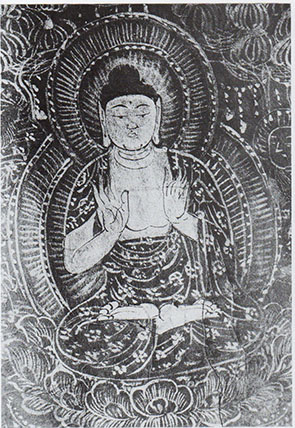
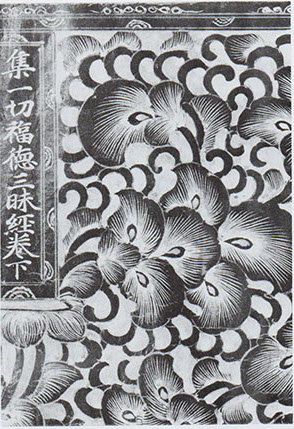
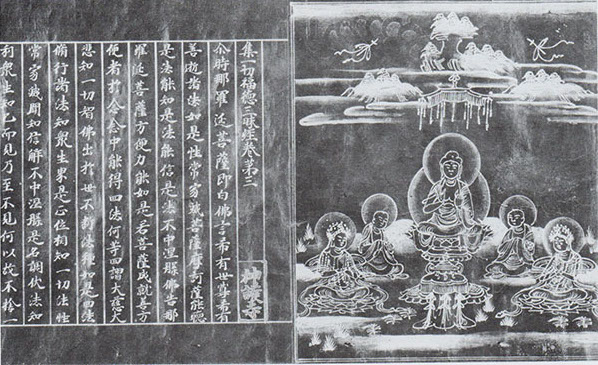
An eagle-shaped mountain always floats at the top center, flanked by two low-lying distant mountain ranges that are topped with schematized pine trees. Seated on a lotus pedestal beneath a simple canopy, the Buddha is attended by two monks and two bodhisattvas. Faces are invariably drawn with a few quick hooks and lines, and feet, even hands, are conveniently hidden by drapery whenever possible. Legs begin to look like limp sausages. On the draped table in front of the Buddha is an incense burner, and the ground in front of this hieratic little group is brushed in with wash and enlivened with a few clumps of grass. A new stability marks these Fig 118 Box Japan. compositions; the figures, however, are smaller, surrounded by much open space and arranged so that they overlap in a real, it limited, spatial setting. Cover designs (fig. 116) have be- woiff, inc., New York, come standardized as well. The silver and gold floral scroll design derives from naturalistic Chinese peony scrolls found on imported Northern Song ceramics and brocades, but now the forms resemble stylized peacock feathers.10 As a further mark of the veneration accorded the holy texts, the Jingoji scrolls were wrapped, in sets of ten, in sumptuous bamboo mats (Pl. 83) woven with threads of dusty blue, green, and red silk that form bands along their width. The custom of making fancy bamboo wrappers must have originated on the continent. A sheet of mica immediately below the strips of bamboo adds a lustrous effect and also protects the contents. The mat is framed with a wide band of silk brocade, and two brass studs in the shape of butterflies once secured the now-lost tie ribbons of braided silk.


Such sets were not meant tube used by the faithful; once they were transcribed and dedicated, they were stored in sturdy lacquered wood boxes in sutra repositories (figs. 118-119). When a special visitor—a retired emperor, for example— made an occasional pilgrimage, some of the temple treasures would be brought out for his enjoyment and study.
Sutra imagery becomes inceasingly personal and intimate in late Heian japan. One text, for example, expounds the meritorious virtue of meditation on the great savior deity Samantabhadra. wise teacher and comforter. Mounted on a six- tusked white elephant, with a host of bodhisattva attendants, he appears to instruct and protect those who read and copy the sutra. In an exquisite painting in the Freer Gallery of Art, Washington, D.C. (Pl. 84), the airborne deity comes alone, without an entourage, swaying gracefully just outside the cave of a monk virtuously reciting his scriptures, which are displayed in a neat row on the low lacquered table in front of him. The intimate bond between the resplendent god and humble devotee is emphasized not only by their physical proximity in a gentle landscape of low, rolling hills, but also by the two rays of light directed downward from the bodhisattva’s forehead.
In Japan, where the role of women was traditionally stronger and proselytizing clergy took a more liberal view of their potential for enlightenment (and were not unmindful of their considerable private wealth), one can detect a distinct feminist bias in sutra illumination of the late Heian period. In a frontispiece of the mid twelfth century illustrating the fifth fascicle of a Lotus Sutra, the emphasis is upon two episodes from Chapter 12 that were of special concern to the Japanese (fig. 120). Sakyamuni is enthroned in the middle distance with monk and bodhisattva attendants, and coming out of the sea directly in front of him is the young daughter of the dragon-king raising high the brilliant jewel of new-found wisdom with a graceful,but emphatic gesture. The young woman and her attendants (ladies-in-waiting, perhaps) wear Chinese costume and carry distinctive long-handled Chinese fans, but all intermediary episodes, including the appearance of her teacher Manjusri and the degrading sex change, so familiar from Chinese examples, have been eliminated. The daughter of the dragon-king has become a symbol of hope for Heian women.
A second episode from this chapter, in the upper-right corner, is rarely if ever seen in Chinese illuminations but was an immediate favorite in Japan. It relates the Buddha’s admonition that even the worst of men, such as Devadatta, Sakyamuni’s evil cousin, might attain Buddhahood because of merit accumulated from good deeds in a previous lifetime. Sakyamuni explains that in a previous existence he was a king. At that time he tried his best to obtain the wisdom of the Buddha but realized that his involvement in ruling the country was inconvenient for seeking the truth. Therefore, he transferred his throne to the crown prince and wandered in search of a person capable of expounding the Great Vehicle to him. One day a seer called Asita came to him and explained that ^g knew the Great Vehicle called the Lotus Flower of the handscroll. Japan; late Heian Wonderful Law and would teach it to the king provided the king would be his obedient servant. The king agreed and began to collect fruit, draw water, gather tirewood, and pre pare meals for him. Thus he served the hermit day and night for many years and finally was permitted to hear the law, with the result that he became a Buddha. Devadatta is the reincarnation of that hermit sage, Asita, and will also become a Buddha in his future life.

The painting shows the Buddha in his previous existence as a king taking the role of servant to the seer: in the continuously unfolding narrative he is shown twice, first carrying firewood and then kneeling in homage before his mentor. Heian courtiers actually adopted this story to suit their own strong tradition of master-follower relationship or clan loyalty. The attendants of a deceased emperor or great Fujiwara minister would assume the role of humble wood bearer or water carrier in splendid dramatic re-enactments of this episode, which served as highlights of weeklong Lotus Sutra ceremonies. A passage from the Tale ofGenji, a novel of court life. written in the early eleventh century, conveys the mood of one such event. To commemorate the anniversary of the death of the old emperor, Genji’s father, his consort made preparations for a solemn reading of the Lotus Sutra.
All the details were perfection, the scrolls to be dedicated on each of the several days, the jade spindles, mountings of delicate silk, the brocade covers.... The wreaths and flowers, the cloths for the gracefully carved lecterns—they could not have been outdone in paradise itself.... The third day brought the reading of the climactic fifth scroll. High couftiers gathered in large numbers, though aware that the dominant faction at court would not approve. The reader had been chosen with particular care, and though the words themselves, about firewood and the like, were familiar, they seemed grander and more awesome than before. The princes made offerings and Genji seemed far handsomer than any of his brothers.11
The Lotus Sutra accounted for nearly ninety percent of all scriptures transcribed during the late Heian period. As the Lotus ceremonies came to be celebrated for the living (often on their birthday) as well as the dead, groups of men and women started to join together to cosponsor a sutra transcription and, thereby, approach enlightenment through their mutual bond with one another and with the Buddha. The cosponsors shared with the principal donor all the spiritual merit that might accrue from such a project. It was a kind of shared spiritual investment, a linking of fates, which was very practical, because it was certainly more economical to divide the costs of such a project among twenty-eight or more participants (one for each chapter) but also very Japanese in its stress on a cooperative work ethic. The participants were necessarily a closely knit group drawn together by strong bonds of personal relationship. Blood relatives, as well as loyal retainers, were united under the sponsorship of the member of the group holding the highest social rank. These events soon escalated into competitive cultural contests: they afforded each participant the opportunity for uninhibited display of personal wealth and provided entertainment on a grand scale.
We have only one detailed account of the preparation leading to a group dedication of this sort. It occurs in an eleventh- century history of the court called A Tale of Flowering Fortunes (Eiga Monogatari), a work focusing on Fujiwara Michinaga and his sons. Michinaga’s daughter, the Empress Dowager Kenshi, was at the center of this project. Late one melancholy autumn evening in the eighth or ninth month of the year 1021 the palace ladies, feeling depressed by the sight of the barren trees, the sound of the insects’ sad song, the cold breeze in the bush clover, and the forlorn calls of departing geese, sat gazing into space and making conversation,
“With everything so uncertain, it’s a serious business to simply go through life accumulating karma burdens,” someone said. “Why don’t we get the gentlemen to help us make and dedicate a copy of the Lotus Sutra? We can do a chapter apiece.” “That would he splendid,” the others agreed. They went to Kenshi with their plan and asked for her opinion. “An excellent idea,” she said, “hut if you start you must be conscientious about finishing the task.” “We ought to be able to manage with thirty capable people.12 First of all, for the Preface, Go no Onkata,” they decided. “For the ‘Tactfulness’ chapter, the Tsuchimikado Mistress of the Wardrobe...”13 With the main decisions- made, they all began to wonder aloud about the best way to proceed, making such a commotion that it was impossible to understand them. The married ones were afraid their husbands’ modest resources might prove unequal to the occasion, and the others felt even more uneasy, since they were going to have to rely on nobles and other gentlemen with whom they were friendly. The enterprise seemed, indeed, to have become less a pious work than a contest, which might, one feared, have the contrary effect of creating a karma burden.
More than ten days of hectic activity followed. (The time was around the Twentieth of the Ninth Month.) The sutra boxes commissioned by Kenshi were ready, the copying had been completed in spite of sundry misgivings, and the ladies were occupying themselves with preparations for the dedication, which they hoped to hold before the end of the month. They had settled on Master of Discipline Ydsho as Lecturer, and had assembled a set of damask and gossamer night-duty robes and 100 rolls of silk as his recompense. Michinaga happened to drop by while they were trying to select a site for the ceremony. Kenshi mentioned the matter to him in the course of conversation. “My ladies have copied a sutra and are wondering where to hold the dedication.”
“Of course they mustn’t think of having it anywhere except at my Buddha Hall,” he said.
“Very well, we shall plan on it.”
“Who is to be the Lecturer? What are you
going to give him?”
“We intend to have Yosho.”
“Excellent. What do you have for him?”
“A damask and gossamer night-duty costume and 100 rolls of silk,” said Naishi no Suke, one of the ladies in attendance.
“Much too extravagant,” Michinaga replied. “I
suggest that you give fifty rolls to the
Lecturer and the rest to the title-chanters.
But when is the dedication to take place?”
“We were thinking of today or tomorrow.”
“Two days from now would be an auspicious date for a Buddhist function. I’ll have my people clean the Buddha Hall. And they’d better straighten up the old monk’s living quarters too. It would be embarrassing if the young ladies- in-waiting laughed at me.” He hurried off home.
Back at the Buddha Hall, he began hasty preparations. “There is to be a sutra dedication. Decorate the Amitabha Hall with rich furnishings, and arrange seating in the south corridor for the ladies-in-waiting. Our friends and relatives among the senior nobles will be coming, so the Kitchen Office will have to get ready for them—and there must be fruits and other dainties for the ladies.”
It was easy to see that Kenshi’s attendants were abashed and agitated by such attentions. The Amitabha Hall was being fitted out with the utmost magnificence.
When Michinaga called at Kenshi’s apartment early on the morning of the dedication, each of the ladies produced her work. The sutra was indescribably magnificent. Some chapters were true chrysographed texts, inscribed in gold on lustrous cobalt-blue paper. Others were written over pictures superimposed on damask, or contained pictures above and below the text, or provided textual illustrations —the “Gushing Forth” chapter, for instance, depicted the emergence of multitudes of bodhisattvas from the earth, and the “Eternal Life” chapter showed the Buddha’s eternal abode on Vulture Peak. It was all quite beyond words. The “Devadatta” chapter was illustrated with a drawing of the dragon king’s abode; others were attached to branches of silver or gold. . . But it would be impossible to describe them all. Their splendor and sumptuousness made them resemble collections of elegant verses rather than sutras. Jeweled rollers had been used, and almost every scroll was embellished with the seven treasures. Nobody had ever seen anything so gorgeous. Kenshi’s sandalwood sutra boxes bore gold-edged figured designs into which multicolored gems had been worked, and she had had the corner decorations made of dark blue Chinese brocade with a tiny figure. Ah, the splendor of it! One would have liked to make just such a sutra to keep always by one.
“I shall put it in the sutra treasury,” said Michinaga, overcome with admiration. He went off with it, leaving word for the ladies to follow at once.
Four or five Household carriages were summoned, and Go no Onkata and the rest of the thirty crowded inside for the journey to the Buddha Hall. They had kept on their usual dress with much reluctance—it would have been only proper, they thought, to make suitable preparations for so grand an event—but to the onlookers, watching them cram themselves helter-skelter into the carriages and start off, it seemed that even the most elaborate special costumes would have served no better, so brilliantly did their attire capture the hues of the season’s chrysanthemums. They alighted at the gallery south of the Amitabha Hall, where the senior nobles were seated in a row against the balustrade of the eastern veranda.
“I didn’t expect the project to amount to much,” said Michinaga, “but I was absolutely astounded and dazzled when I saw the results.” The gentlemen were impressed by the warmth of his praise.
Attractive dishes of fruit were brought to the ladies’ seats, and the gentlemen also partook of refreshments.14The probable appearance of these scrolls may be inferred from a Lotus Sutra dedicated in 1141 by the Retired Emperor Toba, his two consorts, and their ladies-in-waiting and attendants—a group of thirty participants (Pl. 85). The reason for this dedication is not known—there are no words of explanation from the donor—but it may have commemorated Toba’s strengthened ties with the spiritual world earlier that year when he took the tonsure and donned priestly robes. (It may also celebrate the ascendance that month of Toba’s young son, the next emperor.) Lotus flowers, symbolic of the purity of the Buddhist faith, were painted in the margins, and the text was richly embellished with a veritable blizzard of cut gold and silver leaf in large and small particles. The glittering surface boldly communicates the material prosperity and luxury of the Heian court.
The most sumptuous of all Lotus Sutras is the set presented in 1164 by a wealthy warrior family, the Heike, to their family shrine of Itsukushima in the Inland Sea. Known as the Heike Nogyo, or Sutras Consecrated by the Heike, they were made with costly and rare materials intended as tangible evidence of the power and wealth of the donor—the head of the Heike clan would soon rise to the rank of prime minister. Their crystal roller ends are encrusted with gold and silver openwork fittings; the titles on the outer covers are constructed of silver- plated copper plaques with characters hammered in high relief; the paper is of the highest quality and is dyed, printed, and thickly coated with silver and gold leaf to produce the richest possible visual impact. The calligraphy of Chapter 12 (“Devadatta”) is remarkable for the introduction of colored script to harmonize with the variegated hues of the decorated paper. Blue, green, silver, and gold pigments are used in accordance with changes in the ground colors, a subtlety that may well represent the ultimate in Heian aestheticism (Pl. 86). The iconography of the frontispiece is the familiar enlightenment of the young daughter of the dragon-king (see figs. 96 and 120), but now even Sakyamuni has been eliminated in an effort to emphasize her dignity, humanity, and wisdom. She emerges from the ocean at the lower center of the composition, and in the upper-left corner we see her reincarnated as a Buddha expounding the Lotus Sutra in a palace in the Spotless World to the south.
The frontispiece of Chapter 1 of the Heike set depicts the interior of a comfortable Heian country villa, its roof conveniently removed so that we can look directly into the two rooms (fig. 121). At the upper-right edge a young nobleman wearing a tall black-lacquered hat bends over a low table as he concentrates on the line-by-line transcription of the text. In the room below a young lady wearing formal Japanese court robes has opened a tiered black sutra container (not unlike that in Pl. 87) and is intently bent over one scroll, perhaps written by herself, which she has rolled open to read. Beside her a nun enters with a lacquer tray laden with ritual implements, and in the garden a monk is seated in prayer under a makeshift bamboo lean-to. The scene illustrates the passage in Chapter 1 in which a ray of light issues from the Buddha’s brow to illumine, among other things, the monks, nuns, and lay devotees — male and female — who have attained the various fruits of enlightenment by their devotional practices. Included in the scene are the very words of the text written in an angular, formal script around two clusters of rocks in the garden.15

The painting is a translation of the literal content of the sutra into secular imagery, the real world of twelfth-century Japan (fig. 122). Whereas the donors stand inconspicuously to the side in contemporary Chinese illuminations (fig. 93], in Japan they seem to occupy center stage. Another painting of about the same period that may be a donor portrait is the frontispiece of Chapter 28 of a Lotus Sutra in the Yamato Bunkakan, Nara (Pl. 88). The setting is a country temple where lay pilgrims have come to hear priests chant the text of several lavishly decorated sutras displayed on black-lacquered tables. A handsome courtier in a black-lacquered cap fingers his rosary, and two women companions hide their faces beneath their broad-brimmed hats. As for the young lady in green, her attention has wandered and she turns to gaze out at the pine trees.
The general secularization of decorated Lotus Sutras sponsored in court circles during the late Heian period allowed donors to use even poem pages and paintings without a religous content as underdrawings for sutra transcriptions dedicated in memory of the deceased owner of those papers. This is thought to have been the case with some little Lotus Sutra booklets dating from around 1100. The text of the Lotus Sutra and the accompanying sutra devoted to Samantabhadra (Pl. 89) was transcribed on pages of booklets beautifully decorated with printed designs, poems, and illustrations whose original function is no longer clear: they may have been intended as an illustrated poetry anthology. A domestic interior scene, for example, shows two aristocratic young women, a nurse with child, and a sleeping nobleman warming themselves around a central hearth. The women gaze at the white blossoms of a plum tree in their garden. An appropriate verse, a poem from the tenth-century Kokinshu anthology, appears on the following two pages (Pl. 90):
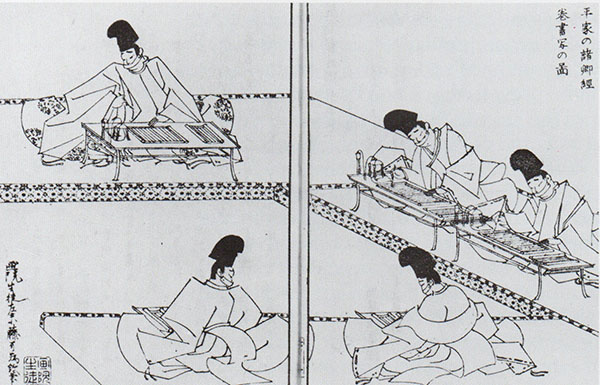
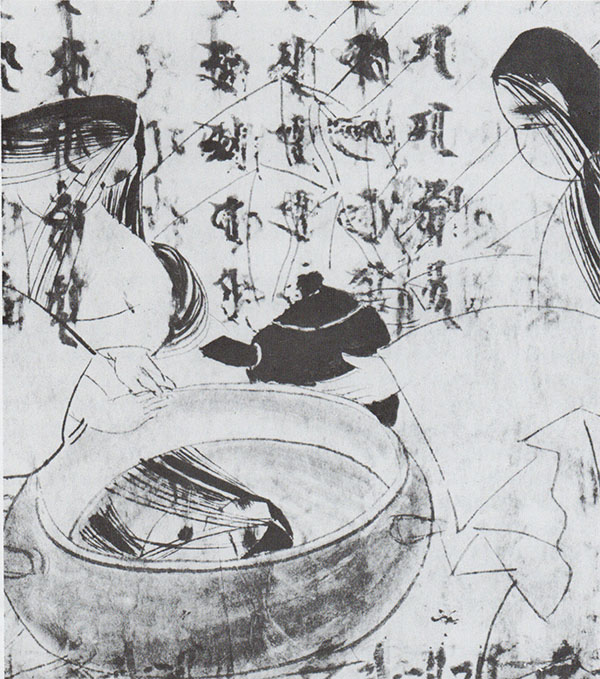
Fuyugomori omoikakenu o ko no ma yori hana to
miru made yuki zo furikeru
Unlikely, we know, with nature in winter’s
grip — and yet to the eye snowflakes
resemble blossoms fluttering between the
trees.16
Although the calligrapher wrote the text of the sutra over the paintings, he apparently did not feel comfortable writing over, or defacing, the poem, which has been enshrined within the scripture.
Uncolored narrative paintings were often used for this same purpose, since the pale ink drawings would not compete with the text. One such example is the midthirteenth-century illustrated Tales oflse, a classical travel diary composed in the early Heian period, over which a Buddhist text was printed with woodblocks.17 In the detail shown here (fig. 123) two women busy themselves at a washbasin. The text is that of a short Sanskrit dharani known as “Bright Luster.” It is roughly printed, over and over again, on both the front and back sides of the paper with a woodblock that is only four lines wide.
John Rosenfield has suggested that the act of printing may have been “part of a ritual, accompanied by prayers and burning incense and the clangor of bells and gongs ... an analogue to the turning of a Tibetan prayer wheel.”18 The charm itself is based upon the power of the cosmic Buddha Mahavairochana and “helps a person to be cured of illness, or banish perplexity and gain the path to enlightenment. It helps the dead to be spared the retribution for their sins and thus escape from hell and be reborn in paradise.” In short, the painting must have been owned by someone of high rank and stamped with the Sanskrit letters at a moment of personal consequence.
A series of serious military rebellions in the midtwelfth century marked the end of the old social order with a ruling class of hereditary aristocrats centered in Kyoto and inaugurated a long period of samurai rule. The emergence of gruesome views of the horrors of hell as a major theme in painting in the late twelfth century reflects the unsettled political and social conditions at that time. Warriors converged from the provinces to fight brutal battles even in the streets of Kyoto, burning and killing as they went. Civil war shattered the genteel world of the upper classes, creating a new interest in themes of retribution and violence. In the Buddhist cosmology are six realms of reincarnation, with hell as the lowest level and the divine realm at the highest. There are eight major hells, each of which has sixteen minor hells. One is reserved for monks and nuns, and the fragment of a hell scroll illustrated here (Pl. 91] reveals the fate of those who torture animals on earth. As described in the text preceding the painting: “Many monks for such cause arrive at the Western gate of this hell, where the horse-headed demons with iron rods in their hands bash the heads of the monks, whereupon the monks flee shrieking through the gate into hell. There, inside, is a great fire raging fiercely, creating smoke and flames, and thus the bodies of the sinners become raw from burns and their agony is unbearable” (translation by Kojiro Tomita).19
Awkward in their nakedness, four defenseless priests run screaming into a curtain of flame, pursued by powerful horseheaded demon-wardens, who perform their task with relish.Dark streaks of mist evoke the smoke-filled limbo of hell.Vivid as well as humorous, the style reflects the love of motion and drama perfected in Japanese narrative scrolls. The theme itself is believed to derive from the Daijo Renge Mezu Rasetsu Butsumyokyo, based upon a translation into Chinese of the Buddhabhashita-Buddhanama-sutra made by Bodhiruchi ' during the Northern Wei dynasty (386-535). Miyeko Murase has observed that “most of the sins discussed in this sutra pertain to violations of the Buddhist canon in the areas of sex, violence, and the consumption of alcohol. The use of such a theme in scroll painting clearly reflects a concern with the moral standards of the clergy.”20
One of the most important Japanese illuminated Buddhist manuscripts is a luxurious handscroll in The Metropolitan Museum of Art, containing the text and illustrations for the Avalokitesvara Sutra, Chapter 25 of the Lotus Sutra. Following the last picture the calligrapher, Sugawara Mitsushige (who is otherwise unknown), signed his name and dated the scroll in accordance with the year 1257. Especially noteworthy is the six-line colophon immediately preceding the last picture, for it reveals that this scroll was copied from a Chinese Southern Song woodblock version printed fifty years earlier, in 1208. The Chinese printed scroll (itself a copy of a painted version) probably found its way to Japan in the luggage of a monk or merchant in the early years of the thirteenth century, a time when trade between the two countries was flourishing once again and when interest in the Lotus Sutra was particularly strong.
As one would expect from the colophon, the Metropolitan scroll shows Chinese influence in many of its details, beginning with the format of the long frontispiece (Pl. 92) in which the Bodhisattva Akshayamati kneels at the center of a circle of deities, monks, and laymen to ask the enthroned Sakyamuni the meaning of the name of the Bodhisattva Avalokitesvara. The paintings alternate regularly with the text in imitation of the format of the original Chinese accordion-pleated booklet in which the width of a picture was regulated by the small size of a page. The figures, moreover, are dressed in Chinese costumes, and the settings feature Chinese architecture with tiled floors and raised stone platforms. In fact, it is clear that many of the compositions were copied almost without alteration from an imported model. Unfortunately, the actual model for the scroll has not survived, and our knowledge of Chinese prototypes is limited to Yuan and Ming dynasty printed books and to their Japanese copies (fig. 124). The iconography of such printed books was transmitted for centuries with little change, however, and we must assume that these later versions closely resemble their Song forerunners.
Nonetheless, there were occasionally willful injections of 20. Murase ig83. p. 55. contemporary Japanese taste. The anonymous court artist introduced techniques of consecutive narration that were developed in the thirteenth century to convey a sense of temporal movement and which helped to dramatize the sutras. In the scene of the fourth peril, for example, the menace of an attacker’s sword (fig. 125), the artist deviated from his Chinese model to create an illustration that is much more lively and amusing. According to the text the attacker’s sword will break in two if only the victim will invoke the name of Avalokitesvara. In Chinese versions the travelers stop to raise their hands in prayer, while the enemy stands stolidly before them with raised sword disintegrating into small parts (fig. 126). The figures are placed near the foreground in a simple, symmetrical composition. In the Metropolitan scroll, by contrast, the attackers are shown actively chasing the hapless victim who has abandoned his luggage in fright. The artist reveals his native inclination in other details as well. The warriors are dressed in familiar Japanese armor, and the landscape backdrop is enlarged with pond, hills, and blossoming cherry trees.
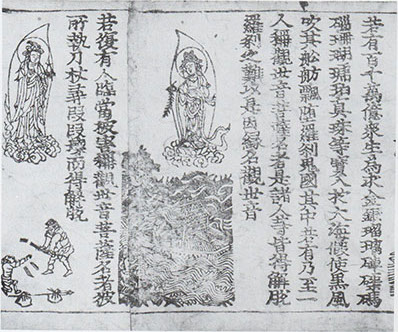
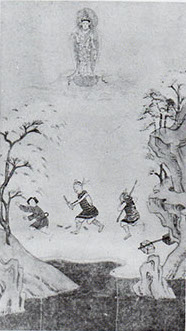 Fig. 125. Menace of
an Attacker’s Sword, from an
Avalokitesvara Sutra handscroll Japan;
Kamakura period, dated 1257. Ink, color,
and gold on paper. H. 23-9 cm. The
Metropolitan Museum of Art, New York.
Fig. 125. Menace of
an Attacker’s Sword, from an
Avalokitesvara Sutra handscroll Japan;
Kamakura period, dated 1257. Ink, color,
and gold on paper. H. 23-9 cm. The
Metropolitan Museum of Art, New York.

In the third prose peril (Pl. 93) the usual scene of a storm- tossed ship at sea is replaced by an image of Avalokitesvara in the guise of a miraculous white horse, to which the merchants cling for salvation, a variant legend popularized in Japanese vernacular literature.21 Both here and in the seventh peril, showing merchants attacked by robbers (Pl. 94), the landscape elements are greatly expanded in a manner and style that was in vogue in contemporary court ateliers specializing in pictorial narrative scrolls.
A few fragments of embroidered Lotus Sutras document the survival of an extraordinary aestheticism that surrounded the cult of this text from the late Heian period. One rare fragment of a handscroll includes twenty-five lines from the closing verse section of Chapter 2, with each line broken in the conventional rhythmic clusters of five characters per verse (Pl. 95; see also Pl. 96).22 It is stitched on thick paper with silk threads of twelve different colors in what appears to be random order; moreover, the characters seem to be embroidered according to the correct stroke order—a technical tour de force. One can scarcely imagine the amount of time and devotion required to complete the entire scroll, not to mention a set of twenty-eight chapters, or scrolls. The characters were first printed on the paper as guides for the embroiderers; but, because this segment is so perfectly preserved, none of the guidelines is visible. The vertical dividing lines are painted in gold; gold and silver leaf scattered in the margins further adds a sumptuous quality to the decoration. Although there is no firm evidence, it is thought that women of the court, or perhaps nuns from aristocratic families, were responsible for the few known examples of embroidered sutras, all of which have been dated to the late thirteenth or fourteenth centuries. Ever since the seventh century, when the widow of statesman Shotoku Taishi (574-622) prepared an embroidered painting known as the Tenjukoku Mandala in her husband’s memory, women had been associated with this technique. No record documents the origin of this unusual embroidered sutra, but it was probably a pious endeavor to promote the salvation of someone recently deceased or perhaps to ensure the salvation of the participants. Subtle variations in the working of the embroiderer’s needle indicate the hand of several individuals. It was without question a cumbersome medium, its very use highlighting the sincerity of the participants in this religious act. Embroidered paintings enjoyed something of a vogue in the thirteenth and fourteenth centuries, although the sutra versions remain comparatively rare (Pl. 97). Occasionally, a devotee used human hair to link the spiritual merits of the act to a particular person, but the inspiration for examples using multicolored silks could well be the colored inks that distinguish Chapter 12 of the 1164 Heike Nogyo (Pl. 86).
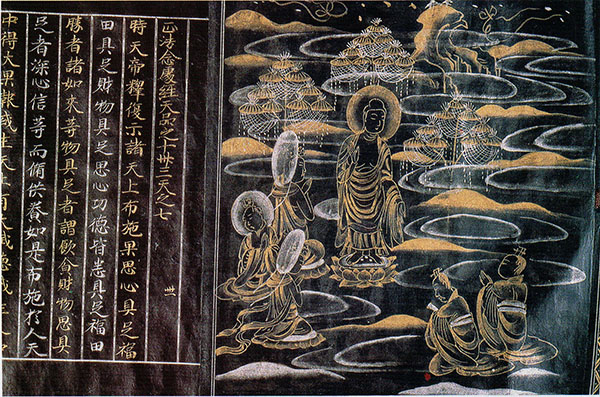
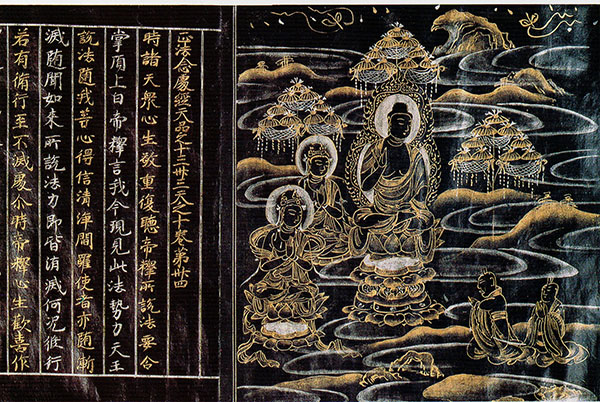





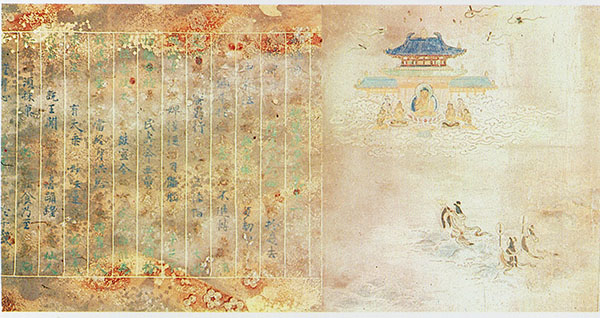







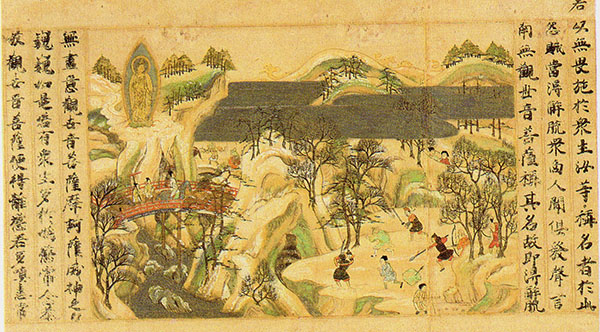

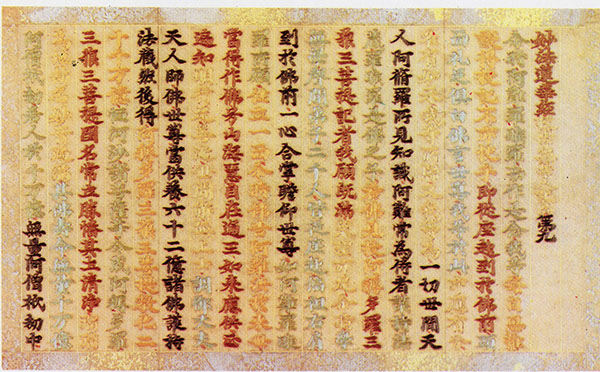
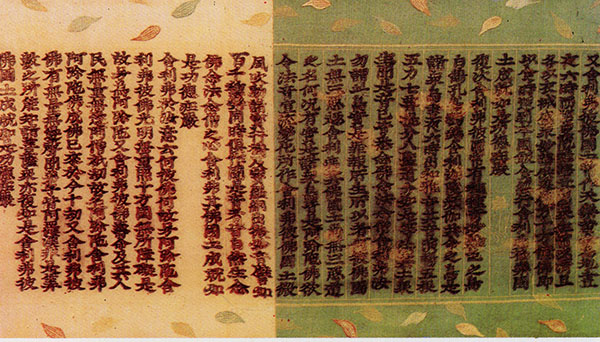

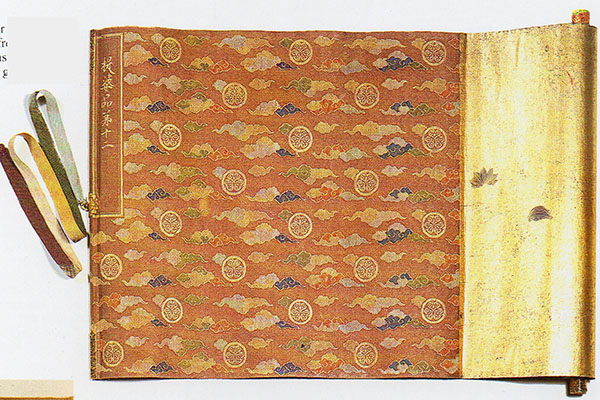
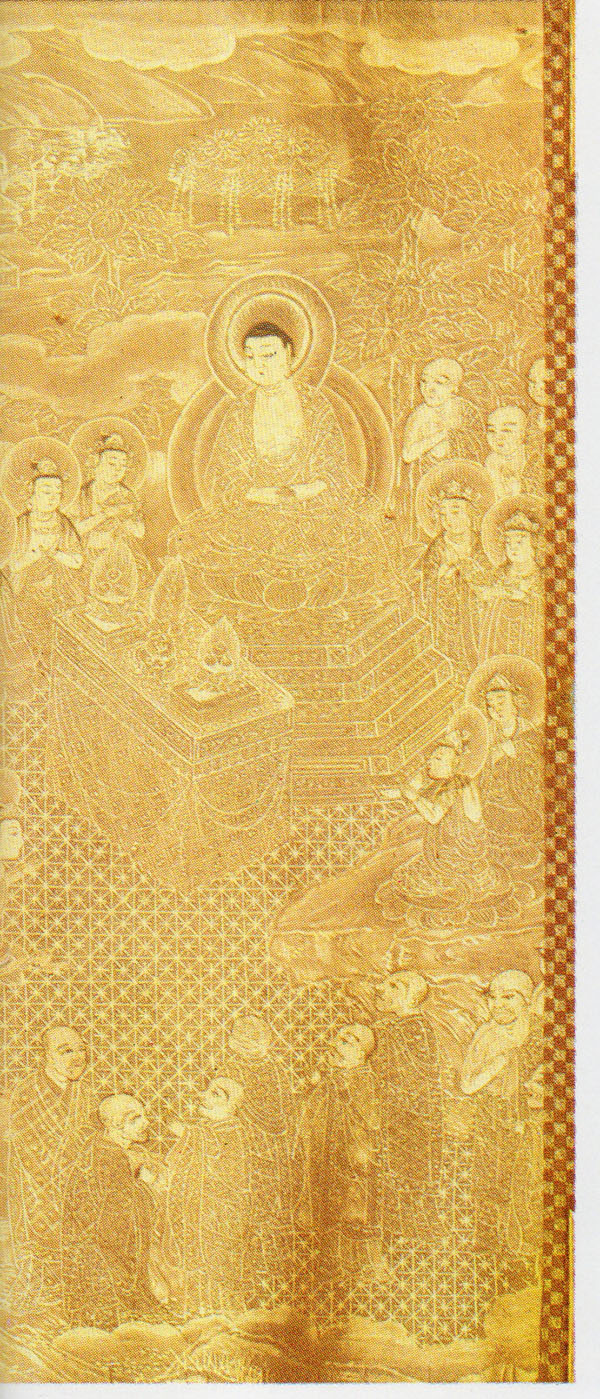
On the whole it is certain that the tradition of illustrated sutras went into decline after the thirteenth century in direct response to the decreasing fortunes of the aristocracy, but there are a few noteworthy exceptions. An especially gorgeous set of seventeenth- century Lotus Sutra scrolls (one for each chapter) is associated with the imperial family and Tokugawa shoguns. Over the past two decades nearly half of the scrolls in this set have found their way into public and private collections in the West, and two are in the Burke collection. 23 Chapter 12 (pis. 98 and 99) includes two favorite scenes: at the upper left the king assumes the humble role of servant to the hermit sage, seated in a cave (fig. 127); below, Manjusri has risen from the sea and presents the young daughter of the dragon-king to the assembly attending the Buddha. Chapter 14 (fig. 128) opens with a dialogue between the Buddha and Manjusri, who is shown seated at the center of the composition and holding his usual symbols, sword and scripture roll. They discuss the ways in which the many bodhisattvas gathered about them may expound the Lotus Sutra in the age of the decline of the teachings after the extinction of the Buddha. Sakyamuni urges that holy men and bodhisattvas meditate in a quiet room and then teach the law to kings, princes, and common people (as seen in the lower-right corner). Those who read and recite this sutra even in a quiet place in the forest (upper left) will be protected by the gods.



When the scrolls were undergoing repair some years ago in the Kyoto studio of Fujioka Kaoru, it was found that Chapter 12 and Chapter 26 both had the date 1667 inscribed on their wood axles by the sutra mounter Hokkyo Ishun.24 The set is very similar in concept and technique to a group of thirty-four scrolls of the Lotus Sutra and accompanying texts dedicated in 1715 to the Rinnoji, a temple on the grounds of the well- known Toshogu Shrine, a mausoleum erected in 1617 to the memory of the deified first shogun, Ieyasu (1542-1616), at Nikko. The scrolls were presented in a shimmering, three- tiered gold-lacquered sutra box with seascape decor. The inventory prepared for the 1715 dedication indicates that the set was presented by the court on the occasion of the one- hundredth anniversary of the death of Ieyasu and that the famous calligrapher Konoe Iehiro (1667-1736] was among the court nobles who participated in this transcription.25 Although most annual festivals at the shrine were carried out with Shinto rituals, the anniversary of Ieyasu’s death was observed with Buddhist rites; Rinnoji was an important temple of the Tendai sect, and its buildings included a Hokkedo, or chapel for meditation on the Lotus Sutra. Moreover, since at least the fourteenth century the chief abbot of the temple had generally been a member of the imperial family.
It appears that the court was in the habit of offering illuminated Lotus Sutras to the Tbshogu at regular intervals, and the 1667 set was very likely commissioned for the fiftieth anniversary of Ieyasu’s death. The brocade covers and gilt-bronze fittings on the crystal roller ends bear the tripartite hollyhock crest of the Tokugawa clan. The covers compare quite favorably with those adorning an album of twenty-eight Lotus Sutra poems presented in 1628 by Retired Emperor Gomizunoo (1596-1680) for the thirteenth anniversary celebration. Gomizunoo, a great patron of the arts, accomplished poet, and devout Buddhist, reigned from 1611 to 1629; in 1620 he took the daughter of the second Tokugawa shogun. Hidetada, to be his empress. He was succeeded by their daughter, who became Empress Meisho.
The lavish use of gold and elaborate decorative techniques (designs in the text margins and on the back are stenciled in gold, silver, and various colors) have caused this set to be dubbed the Heike Nogyb of the Edo period. Such extravagance suggests an imperial commission, and there is speculation that the artist may have been Tosa Mitsuoki (1617-91). director of the Imperial Paintings Bureau. In the seventeenth century, when upper-class taste preferred specific realistic detail and fine craftsmanship, Tosa artists set new standards for delicacy and refinement. Exquisite miniatures were their hallmark, but the sheer multiplicity of detail (where there were two bodhisattvas, there are now ten or more) tends to distance the viewer from the subject. The mystery and subtlety of the classical age of Buddhist art are no more; instead, a more playful and perhaps even superficial beauty is apparent. Further, the use of small, geometric patterns in the background and the off- 25. Nikkosan 1966, p. 126. center, three-quarter view of the Buddha are strongly reminiscent of Korean models, which may have been enjoying a vogue in Japan at the time.26
During the late eighteenth century—one of the most creative periods in the history of Japanese art—some artists experimented with new and unusual sutra transcriptions in the form of hanging scrolls. These exemplify the final flowering of the rich tradition of illustrated sutras in Japan, and prove that there was still room for originality and innovation. The artist Ike Taiga (1723-76) was born into a rural family on the outskirts of Kyoto. At the age of fourteen he opened a fan shop in the capital to support himself and his widowed mother. A child prodigy, he was largely self-taught and quickly developed into an astonishingly prolific and talented artist, as gifted in the art of calligraphy as in painting.
The isolation policy of the Tokugawa regime made it impossible for Japanese artists to travel abroad. It also made them all the more curious about the forbidden world outside. Like many of his contemporaries who were restlessly searching for fresh sources of inspiration, Taiga especially admired the subject matter and style associated with the Chinese literati, high-minded Confucian gentlemen painters. His works were accordingly restricted to landscapes, the so-called Four Gentlemen subjects (bamboo, plum, chrysanthemum, and orchid), and figures.
Taiga also produced a small group of ten or more Heart Sutra paintings, all thought to date from the 1760s and 1770s, when the artist was in his forties. The Heart Sutra describes itself as “the great spell, the spell of great knowledge, the utmost spell, the unequalled spell, allayer of all suffering.”27 A powerful synthesis of the content of the larger sutras, it contains only 217 Chinese characters. Because of its brevity, the sutra is easily memorized and copied. The great ninth-century cleric Kukai remarked, “it is simple yet comprehensive; it is terse yet profound.”28 The Heart Sutra has always been popular with pious laymen, one extreme example being that of the celebrated courtier and calligrapher Konoe Iehiro, who is said to have transcribed this text almost every day of his adult life.29
One of Taiga’s Heart Sutras includes an overt religious image, the White-robed Avalokitesvara (the bodhisattva is invoked at the beginning of this sutra), but other scrolls feature a somber mountain landscape or a modest spray of bamboo, purely secular motifs in the ink-painting style associated with the Chinese literati (figs. 129 and 130). Bamboo, for example, was one of the greatest Chinese symbols for the upright scholar. Admired for its straightness, bamboo is resilient and will bend but will not break easily. In the genre of ink bamboo it was not the mere display of skill and verisimilitude that was of primary importance, but rather the easy, gentlemanlike demeanor, the seemingly casual and free organization. The abstract qualities of calligraphy, the interweaving of personality and brush and ink, were extolled by Chinese exponents of this subject.30 Taiga’s bamboo paintings may owe a debt to Dapeng Zhengkun, known in Japan as Taiho Shokon (1691-1774), the Chinese monk who arrived in Japan in 1722 to serve as both the fifteenth and eighteenth abbot of Mampukuji, from which he retired in 1765.31
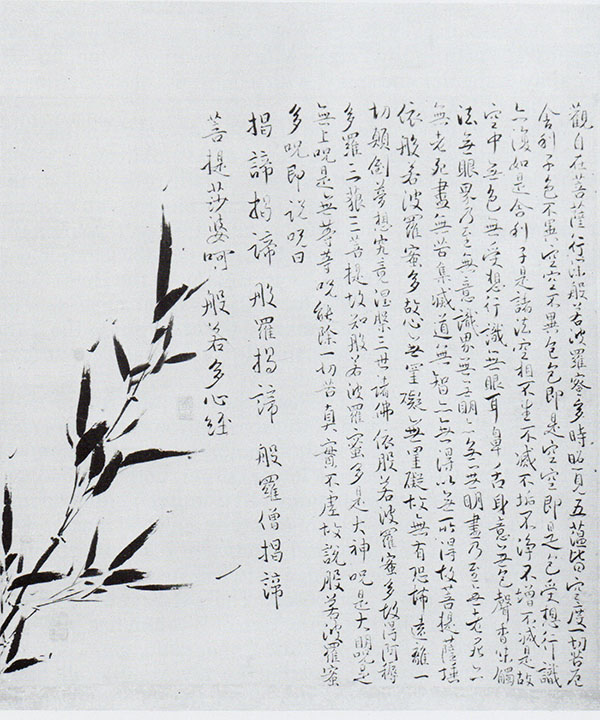

Located in Uji, southeast of Kyoto, Mampukuji Monastery was founded in 1661 by a Chinese monk as the headquarters of the Obaku (HuangboJ sect of Zen Buddhism. Architecture, liturgy, dress, and customs were entirely Chinese, and a succession of abbots from China ensured its preservation as a flourishing center of mainland culture, attracting a growing number of sinophiles. As with so many of his colleagues, Taiho was an amateur priest-painter, a prolific practitioner of dense, boldly painted ink-monochrome bamboo. It was he who invited his friend Taiga in the 1760s to create a set of eight large finger-painted sliding door panels depicting the five hundred arhats (advanced disciples of the historic Buddha) for Mampukuji. Taiga undoubtedly had strong intellectual and spiritual ties with Zen; his association with the Obaku sect is further documented by a Heart Sutra hanging_scroll dated 1768 that he gave to a young Japanese-born Obaku monk named Monchu (1739-1829) who had come to Kyoto from his home on the Ise peninsula to study and serve at various temples. Monchu, in turn, is known to have inscribed a poem on a landscape painting by Taiga’s wife, Gyokuran. Monchu calligraphy is angular and spiky, with a lightness of touch that recalls that of Ike Taiga.32
Taiga was a fervent devotee of Bodhisattva Avalokitesvara, and his small personal icon, a statue of Avalokitesvara measuring seventeen centimenters high, is still preserved in the Taiga Museum, Kyoto. He worshiped the image as an emblem of salvation, and took it for ritual purification each year on the occasion of the July 7 ceremony at the Kiyomizu Temple waterfall.33 In a similar vein, his transcriptions of the Heart Sutra represent a serious act of devotion. It has been suggested, on the basis of consistent omissions and peculiarities in the transcription of certain characters, that he was actually copying an Obaku text.


The paintings in Taiga’s Heart Sutra scrolls fill no more than one-half or one-third of the scroll surface; they are simply and quickly brushed, without color, so as not to compete with the text. Grounded in a lower corner, both bamboo and craggy hills thrust diagonally upward to enliven,but not dominate the surface. These are not carefully finished masterpieces; they lack the vibrancy and fluidity of his more finished works in color, but the balance between image and block of words is thoughtfully composed. The sutra ends with the haunting passage: “By the Perfection of Wisdom has this spell been delivered. It runs like this: Gone, gone, gone beyond, gone altogether beyond. O, what an awakening, all hail!” Taiga isolates and enlarges the characters of this dramatic closing mantra in one long column on the far left in the landscape painting and in two shortened columns in the bamboo painting. In the former example he has also written the mantra in a more archaic script form.
It is obvious, of course, that Taiga is not a professional sutra writer; he crowds his words to the margins of the scroll and his columns of characters slant perceptibly to the right. He writes in a highly idiosyncratic style, far removed from the classical formality of traditional Buddhist discipline. These scrolls are proof that in the Edo period the son of a farmer had as much right (and ability, thanks to widespread education sponsored by temple schools) as a high-born prince or Buddhist monk to transcribe the sacred texts.
Perhaps the most astonishing act of lay piety is the set of fifty hanging scrolls representing the five hundred arhats by a scholarly bureaucrat in the Tokugawa shogunate, Kato Nobukiyo (1734-1810) (Pl. 100 and figs. 131, 132). Nobukiyo was a skilled swordsman of the samurai class who, in an era of peace and plenty, was content to use his talents in the service of the central government. In his early fifties, a stage of life when Buddhists traditionally set aside a period of time for ascetic withdrawal and meditation, he took vows of abstinence and separated himself for five years from his family in order to carry out the tremendous project of copying a famous set of fifty arhat paintings in the collection of Tofukuji, a Zen temple in Kyoto.34 The Tofukuji set is attrributed to the Zen painter Mincho (1352-1431). Nobukiyo’s version distinguishes itself by the fact that it is not painted in outlines (although it gives that illusion when seen from a distance), but is written with multicolored characters of the Lotus Sutra that create forms, texture, and even solid areas of color. This combination of pictorial image and scripture has its precedents in earlier centuries when sutras were transcribed in the shape of pagodas (see fig. 85), but Nobukiyo’s obsessive, single-minded devotion to a noble cause is singularly Japanese.
In Japan, as in other Buddhist countries, belief in the material manifestation of piety led to the building of temples and the production of Buddhist books. Many of Japan’s greatest calligraphers, both monks and laymen, applied themselves to sutra copying, undeterred by the time-consuming nature of this work. The greater the labor, the greater the religious merits to be gained. Buddhism found its most enduring success in ,Japan (even today more than six-sevenths of the population profess the Buddhist faith),and the writing and illumination of scriptures became a major industry. The evolution of decorated sutras during the Heian period stands out as a high point in the history of illuminated Buddhist manuscripts in Asia. The commissioning of ornate scrolls reached its apogee in the twelfth century, a period of remarkable aestheticism in Japanese art, but was emulated for centuries thereafter.
Special characteristics of sutra illumination that are distinctly Japanese emerged during the Heian period. The more formal style and convention-bound imagery associated with China was intentionally rejected and a brilliant national style was born. This was due in part to the lively participation of lay donors, a highly refined aristocracy. The Buddhist stories and deities began to be humanized,and the frontispiece illustrations developed a strongly emotional appeal. The Japanese are inclined to equate the world or the individual self with ultimate divinity, and it was not uncommon to find a Buddhist guardian depicted in the guise of a contemporary court lady. By secularizing the pictorial imagery and presenting it in a playful and witty fashion, artists made the scriptures relevant to their daily lives. Beautiful presentation is typical of the finest sets of Japanese sutras, and so too is a tendency towards simplification and even abstraction of design.
A neo-Confucian government in the Edo period hastened the decline of Buddhist arts, but as literacy spread, the scriptures became available to a broader public and the art was accordingly less elitist. Edo period sutra transcriptions include some of the most adventurous of their kind, going far beyond the limits of orthodoxy characteristic of most Buddhist scripture illumination in Asia.
